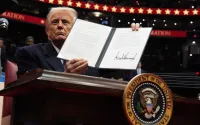9 February 2007The Independent
The latest "green" offering by Sir Richard Branson has much to commend it. If scientists can devise a sustainable and cheap way of capturing and storing the CO2 being pumped into the atmosphere, it could amount to a huge breakthrough in tackling climate change.
However, this initiative by Sir Richard has to be seen in the wider context of what else he is doing to encourage the profligate use of fossil fuel - such as generating a new market for space tourism where none yet exists. Almost everyone today uses airlines at some time to get from one place to another. But what is the use of a trip that takes you nowhere but 70 miles above ground - with the "space" bit of the ride lasting just a couple of minutes?
Virgin Galactica, the company set up by Sir Richard to offer trips in space, estimates that there are 3,000 people in the world who are rich enough and keen enough to spend £100,000 on a ticket. The first flights are scheduled for 2009, but Sir Richard says he wants to bring down the price so that all of us can go into space. Virgin Galactica's publicity extols the virtues of the "howl of rocket motors" and "eye-watering" acceleration. It even describes the 90-second view from the aircraft: "The incredibly narrow ribbon of atmosphere looks worryingly fragile. What you are looking at is the source of everything it means to be human." There is no mention, however, that for a 90-second thrill, space tourists will have produced a carbon footprint many times bigger than the equivalent 90 seconds spent on a transatlantic jet - not to mention other modes of transport.
Sir Richard says that he wants to make a difference. He says he wants to use his influence and wealth to leave a better world for our children and our children's children. The prize he is announcing today to capture and store man-made CO2 is a commendable gesture in that direction. But how does he square that with his desire to turn us all into an army of carbon-crazed space cadets?






